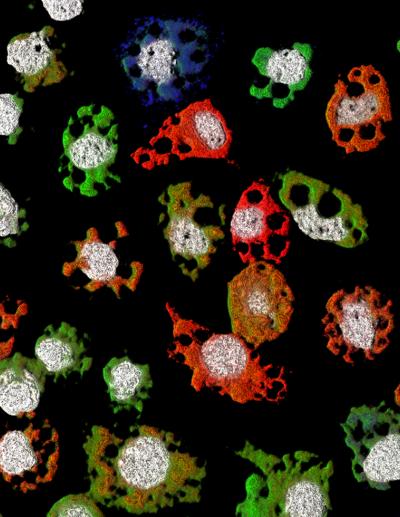Newly discovered 'multicomponent' virus can infect animals

Multicomponent viruses, which separately package different genome segments, were thought to be restricted to plant and fungal hosts. Ladner et al. characterize a multicomponent mosquito virus and describe an evolutionarily-related, segmented virus in a non-human primate. These findings provide evidence for multicomponent animal viruses and suggest relevance to animal health. Photo depicts the presence of different viral RNA segments within infected cells. Credit: Michael Lindquist, USAMRIID (US Army Medical Research Institute of Infectious Diseases)
This new pathogen, called Guaico Culex virus (GCXV), was isolated from several species of mosquitoes in Central and South America. GCXV does not appear to infect mammals, according to first author Jason Ladner, Ph.D., of the U.S. Army Medical Research Institute of Infectious Diseases (USAMRIID). However, the team also isolated a related virus — called Jingmen tick virus, or JMTV — from a nonhuman primate. Further analysis demonstrates that both GCXV and JMTV belong to a highly diverse and newly discovered group of viruses called the Jingmenvirus group.
Taken together, the research suggests that the host range of this virus group is quite diverse–and highlights the potential relevance of these viruses to animal and human health.
“Animal viruses typically have all genome segments packaged together into a single viral particle, so only one of those particles is needed to infect a host cell,” Ladner explained. “But in a multicomponent virus, the genome is divided into multiple pieces, with each one packaged separately into a viral particle. At least one particle of each type is required for cell infection.”
Several plant pathogens have this type of organization, but the study published today is the first to describe a multicomponent virus that infects animals.
Working with collaborators including the University of Texas Medical Branch and the New York State Department of Health, the USAMRIID team extracted and sequenced virus from mosquitoes collected around the world. The newly discovered virus is named for the Guaico region of Trinidad, where the mosquitoes that contained it were first found.
In collaboration with a group at the University of Wisconsin-Madison, the USAMRIID investigators also found the first evidence of a Jingmenvirus in the blood of a nonhuman primate, in this case a red colobus monkey living in Kibale National Park, Uganda. The animal showed no signs of disease when the sample was taken, so it is not known whether the virus had a pathogenic effect.
Jingmenviruses were first described in 2014 and are related to flaviviruses — a large family of viruses that includes human pathogens such as yellow fever, West Nile and Japanese encephalitis viruses.
“One area we are focused on is the identification and characterization of novel viruses,” said the paper's senior author Gustavo Palacios, Ph.D., who directs USAMRIID's Center for Genome Sciences. “This study allowed us to utilize all our tools–and even though this virus does not appear to affect mammals, we are continuing to refine those tools so we can be better prepared for the next outbreak of disease that could have an impact on human health.”
While it is difficult to predict, experts believe that the infectious viruses most likely to emerge next in humans are those already affecting other mammals, particularly nonhuman primates.
###
This research was supported by the Defense Threat Reduction Agency, the National Institutes of Health, the James W. McLaughlin endowment fund, a Smithsonian Tropical Research Institute-Environmental Protection Agency grant, and a Robert E. Shope fellowship.
USAMRIID's mission is to provide leading edge medical capabilities to deter and defend against current and emerging biological threat agents. Research conducted at USAMRIID leads to medical solutions–vaccines, drugs, diagnostics, and information–that benefit both military personnel and civilians. The Institute plays a key role as the lead military medical research laboratory for the Defense Threat Reduction Agency's Joint Science and Technology Office for Chemical and Biological Defense. USAMRIID is a subordinate laboratory of the U.S. Army Medical Research and Materiel Command. For more information, visit http://www.
Reference: Cell Host & Microbe, Ladner et al: “A Multicomponent Animal Virus Isolated from Mosquitoes” http://www.
Media Contact
All latest news from the category: Health and Medicine
This subject area encompasses research and studies in the field of human medicine.
Among the wide-ranging list of topics covered here are anesthesiology, anatomy, surgery, human genetics, hygiene and environmental medicine, internal medicine, neurology, pharmacology, physiology, urology and dental medicine.
Newest articles

First-of-its-kind study uses remote sensing to monitor plastic debris in rivers and lakes
Remote sensing creates a cost-effective solution to monitoring plastic pollution. A first-of-its-kind study from researchers at the University of Minnesota Twin Cities shows how remote sensing can help monitor and…

Laser-based artificial neuron mimics nerve cell functions at lightning speed
With a processing speed a billion times faster than nature, chip-based laser neuron could help advance AI tasks such as pattern recognition and sequence prediction. Researchers have developed a laser-based…

Optimising the processing of plastic waste
Just one look in the yellow bin reveals a colourful jumble of different types of plastic. However, the purer and more uniform plastic waste is, the easier it is to…



